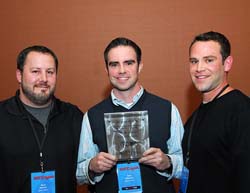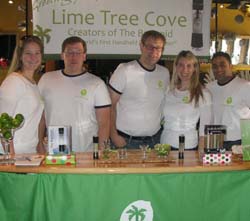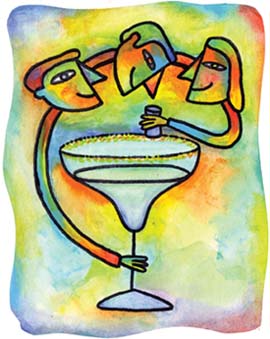 |
 |
| current issue |  |
past issues |  |
send a letter/news |  |
address update |  |
advertise |  |
about us |  |
alumni home |
Features
Launch PadYoung alumni entrepreneurs follow their dreams
By Suki Casanave '87G
Illustrations by Philippe Béha, all rights reserved
Ever heard of the woman who sells clothes made from corn? How about the guy who invented a way to re-salt a margarita glass? Someone else has a knack for dealing with difficult brides. Another fellow fits families on vacation with ski equipment in record time. And then there's the expert on sword fighting and the designer who has a chocolate bunny for a client—well, sort of. Who are these people?

|
Entrepreneurs, one and all, they're inventors and innovators, dream-followers and leap-takers. They're graduates of UNH, too, a university that's been named one of the nation's 10 most entrepreneurial colleges by the Princeton Review and Forbes.com.
It wasn't always this way. For many years, entrepreneurship at UNH—and throughout academia—wasn't even considered a field, notes Mike Merenda, professor of strategic management and entrepreneurship in the Whittemore School of Business and Economics. But during the past 20 years there's been a dramatic change. "The country's seen an explosion of majors and centers, journal articles, conferences and professional associations," he says. And UNH has been a leader in this evolution.
"We were there before the bandwagon," says Jeffrey Sohl, director of UNH's internationally recognized Center for Venture Research and a WSBE professor. Sohl's mentor and predecessor, William Wetzel, helped establish the center in 1984 and taught a small-business development class way back in the 1960s. And for more than two decades, the school's Holloway Prize has encouraged students to develop business plans for bringing innovative products and services to market. The competition helps students gain firsthand experience in commercialization, provides them with access to faculty advisors and industry experts, and gives them a chance to win up to $10,000 in seed money.
Introduced about a decade ago, WSBE's entrepreneurial studies option is for business administration majors who want to tackle the challenge of building a company from scratch. Students take courses in management, marketing and private equity and venture capital, as well as an internship course that matches students with new companies in various stages of development. In the past few years, the college has doubled the number of sections of the demanding but popular internship class, where students put in 8-10 hours a week typically in a high-growth, high-tech setting. "Our strength is this integrated approach," says Merenda, "this mix of academics with this real-life, hands-on experience."
|
Seeking more entrepreneurs Are you an entrepreneur? Let us know and we'll add your business to this story. We're also looking for established entrepreneurs for the second installment of this story, in the Fall 2011 issue. Contact us at alumni.editor@unh.edu. |
Even non-business majors are catching the entrepreneurial wave these days in an honors course that explores innovation and the meaning of entrepreneurship. The Holloway competition, too, recently expanded to include all disciplines. And next year, a new two-semester course will mix business majors and students from the College of Engineering and Physical Sciences and the College of Life Sciences and Agriculture. Not only will students create business plans and a company, they will attempt to bring in revenue. The goal, according to Merenda, is to expose students to just about every challenge that comes with launching a brand-new idea.
All of the alums featured here, along with others on the magazine's website, know a thing or two about launching a brand-new idea. Some emerged straight from UNH's entrepreneurial studies program. Others have never taken a business course. But all of them are recent graduates who share a spirit of adventure, a vision and an impressive work ethic. In the next issue, readers will meet alums who have spent years growing their startups into successful companies. These seasoned entrepreneurs began, like those profiled here, with nothing more than an idea. They all had dreams—and they followed them. ~
Read on for young alumni entrepreneurs profiled in the Spring 2011 issue.
Go directly to additional alumni entrepreneurs

|
Company: Lightfin Studios
Website: www.lightfin.com
What:
Banks, beer and bunnies—Lightfin Studios in Portsmouth, N.H., started by D.J. Haskins '99, '05G (pictured, right) and Sam Giberson '00 (pictured, center) in 2006, develops websites and online marketing strategies for a host of companies, including one for a world-famous chocolate rabbit, the Lindt Gold Bunny.
In the Beginning:
Haskins, Giberson and Sean Reusch were co-workers at a successful company, but they realized that between them they had the skills to start their own, smaller firm. And so they jumped.
Smart Move:
"We didn't want to open our doors in debt," says Giberson, "so we never looked for outside funding." They spent a year freelancing nights and weekends to save up money. They also trained themselves to ignore the possibility of failure. "It's like golf," says Giberson. "You are not going to hit well if you think about the bad things that might happen."
 |
The Pitch: Lightfin takes a WYSIWYG approach: What you see is what you get. "Lots of bigger companies show potential clients their award-winning work—and then switch you to their junior team," says Haskins. "We have the talent of a large agency, but we offer a different level of service and involvement."
Back Story: "I took a couple of entrepreneurship classes at UNH," says Haskins. "In one, we built a business plan. Looking back, 80 percent of what we learned has been really helpful. But 20 percent—sales projections, how fast you'll grow—you can't learn that until you start a business and see how hard it is."
Favorite Quote: "Leap and the net will appear."

|
Company: Lime Tree Cove
Website: www.limetreecove.com
Why It's Cool:
"With just the push of a button, anybody can be a cocktail hero," notes Tim McCaffery '00, '02G, who started the Boston company, a division of Lime Design, in 2006.
In the Beginning:
The idea was sparked by a not-quite-perfect gift for his wife, Holli Bessant McCaffery '01. "I bought margarita glasses," says McCaffery. "But they were too small—she'd run out of salt before she finished the drink." A problem was born: How do you re-salt a half-filled margarita glass? The solution was the Barmaid.
Turning Point:
When it was time for testing, McCaffery enlisted the help of members of the local Jimmy Buffet Parrot Head Club, margarita enthusiasts all. "We gathered customer feedback and refined our design," says McCaffery, who brought on UNH friend and fellow engineer Zach Zguris '98, '00G, '08G as his chief technology officer. Holli, who stars in Lime Tree Cove's promotional videos, is the company's chief financial officer.
 |
Back Story: Before the Barmaid, McCaffery worked for the U.S. Army, designing protective suits and gas masks for soldiers. It's a job that called on both his UNH degrees—a B.S. in chemical engineering and a master's in material science. He spent several years consulting and got a second master's from MIT. It's all been useful, he says. Whether you're working on military equipment or a cocktail spice dispenser, the basic question is still the same: How do you design and build a successful product? "Our ultimate goal is to bring out many products," he says.
Photo: Heather Brundage; Zach Zurgis '98, '00G, chief technology officer; Tim McCaffery '00, '02G, founder; Holli Bessant McCaffery '01; Rishi Dean
Page: 1 2 3 4 Next >
Easy to print version
blog comments powered by Disqus
